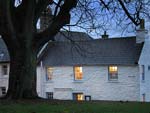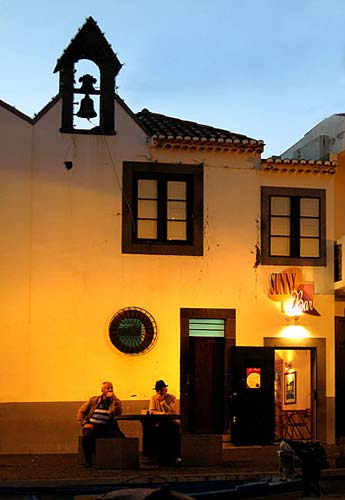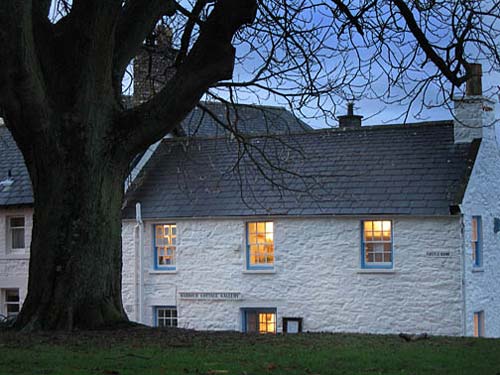How to Photograph Mixed Light
 Our fifth Christmas guest writer, long-time professional photographer Philip Dunn from PhotoActive, shares his top tips for taking great photos of mixed light.
Our fifth Christmas guest writer, long-time professional photographer Philip Dunn from PhotoActive, shares his top tips for taking great photos of mixed light.
Ever wondered how to create those wonderful atmospheric exterior photographs where golden light from a house window streams into the cold, blue light of the street? You must have seen them – National Geographic photographers use this technique all the time when taking pictures of villages or towns. Advertising photographers use it when photographing hotels and guest houses. It’s a really old trick to make the place look cosy and inviting – the front door is often left open so that yellow light spills out onto the doorstep.
This technique is easy provided you understand what’s happening to create all those lovely deep yellows and blues. It’s all about colour temperature and ‘mixing’ the high temperature blue light of dusk with the low temperature yellow light of interior tungsten lighting.
Think what happens at sunset – you take lots of colourful pictures with lovely oranges and reds in the sky. Perhaps your pictures include the silhouettes of buildings in the foreground. Then the sun goes down below the horizon - the reds disappear from the sky as the sun sinks way down. It is now almost dark – twilight – so dark that people have to switch on the lights in those buildings so they can see what they are doing. Take more picture right now. This is your opportunity to ‘mix’ different coloured light – yellow tungsten and blue twilight – it doesn’t last long, usually no more than 10 minutes, so make the most of it.

Caption: Mixing high (blue) and low (yellow) colour temperatures can be very effective when trying to capture the atmosphere of a place – particularly in travel photography. This picture was taken on Madeira. There was no time to set up a tripod; the camera was just rested on a wall for an exposure of 1/6sec at f4.
So what is happening? Well, it’s all about colour temperature, and this is measured by the Kelvin scale. You may even have a ‘K’ setting on the White Balance (WB) function on your camera. According the Kelvin scale, normal daylight (the sun on a blue sky with a few small clouds) measures around 5,500K. When it goes cloudy, the light gets bluer and climbs up the scale to perhaps 6,500K. You’ll notice that the Kelvin scale works opposite to our normal logic – we think of warm light as red light and cold light as blue – you’ll just have to accept this, I’m afraid.
Twilight can sometimes reach an intensely blue 10,000 or even 15,000K. That really is very blue, while an ordinary household bulb is at the other end of the scale – about 2500K – and will register as very yellow in your camera.
The nice thing is you don’t have to bother with these numbers if you don’t want to. All you have to do is set your WB on the ‘Sunny’ icon and shoot away. By locking it on the ‘Sunny’ icon, you will intensify both the yellows and the blues. But experiment. Every situation is different and you may find you get better results by using the Auto White Balance (AWB) setting.

Caption: Here, I have put the camera on a tripod, used a low ISO and a slow shutter speed. The tungsten lighting in the windows makes a colourful contrast to the blue light of dusk. Remember, the opportunity to capture mixed light does not last long – so be prepared.
Top Tips
If possible, put your camera on a tripod or rest it on a firm object because you will need to use a slow shutter speed to capture the ‘mixed’ light of twilight – come on, it’s going dark!
If the camera is on a tripod, you do not need to use a high ISO setting – because you will not need a fast shutter speed. The lower the ISO, usually the better the quality.
Twilight does not last long – so set up you camera beforehand and be ready.
Biography
Philip Dunn has been a professional photographer for 40 years. His first picture was published when he was just 14 years old. After working on local and regional newspapers, he joined the staff of The Daily Express for 15 years before going freelance. He has travelled the world for The Sunday Times and on commissions for almost every top magazine and newspaper in UK. He has illustrated many books and now runs photography holidays and courses in Scotland and overseas.
Philip Dunn’s instructional DVD ‘Light and Composition’ covers the art of using mixed light and much more. You can buy it now at: http://www.photoactive.co.uk/index.php/photographydvds/
His new DVD ‘Portraits in Natural Light’ is also available now from his website:
http://www.photoactive.co.uk
If you’d like to know more about how to understand colour temperature, Philip Dunn has posted an article on his blog:
http://www.photoactive.co.uk/index.php/2008/12/the-colour-of-light-in-photography
All images in this article © Philip Dunn

Loading comments…